Master these 10 mobile photo techniques to create compelling social media stories. Use the rule of thirds for balanced compositions, harness natural lighting for ideal illumination, and employ leading lines to guide viewers' eyes. Incorporate negative space for emphasis, apply color theory to evoke emotions, and capture candid moments for authenticity. Experiment with reflections and silhouettes for visual intrigue, focus on textures and patterns for depth, and manipulate depth of field for professional-looking shots. Finally, embrace imperfect compositions to add a touch of reality. These techniques will transform your ordinary snapshots into enchanting visual narratives that resonate with your audience.
Rule of Thirds Composition

One of the most powerful composition techniques you can use in your mobile photography is the rule of thirds. This principle involves dividing your frame into a 3×3 grid and placing key elements along these lines or at their intersections.
It's a simple yet effective way to create balanced, visually appealing images that draw the viewer's eye to the main subject.
To apply the rule of thirds, activate your phone's grid feature in the camera settings. As you frame your shot, position important elements along these gridlines.
For landscapes, align the horizon with either the top or bottom horizontal line. When capturing portraits, place your subject's eyes near one of the upper intersection points.
Natural Lighting Mastery
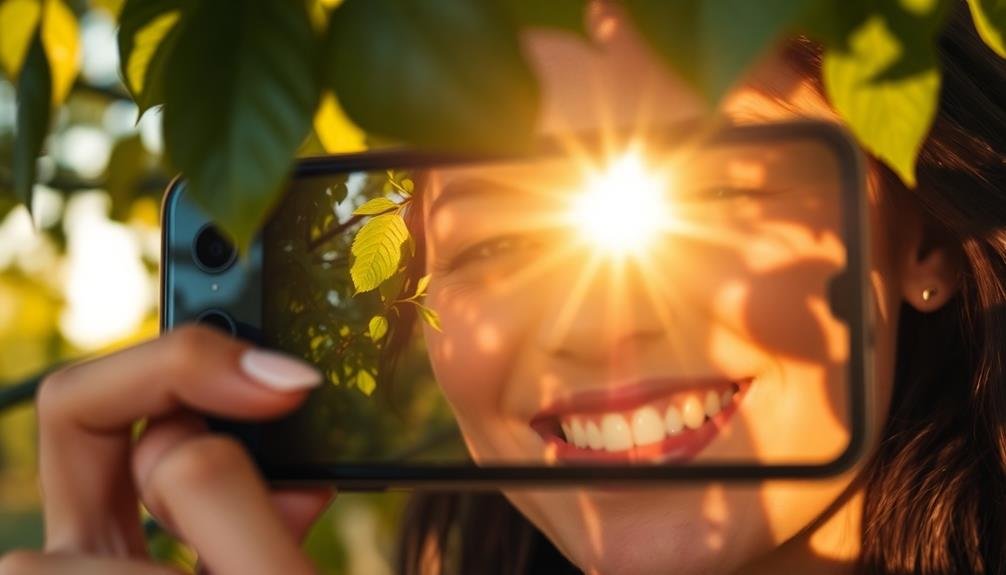
Light, the essence of photography, can make or break your mobile shots. Mastering natural lighting is essential for creating compelling social media stories. When you're shooting outdoors, pay attention to the sun's position and how it affects your subject. Soft, diffused light during golden hour (just after sunrise or before sunset) can add warmth and depth to your images.
To elevate your natural lighting skills, focus on these key aspects:
- Direction: Observe how light falls on your subject and adjust your position accordingly.
- Quality: Recognize the difference between harsh midday sun and soft, overcast light.
- Color temperature: Use white balance settings to capture accurate colors in varying light conditions.
Indoors, position your subject near windows to harness natural light. Avoid using your phone's flash, as it often results in unflattering, flat images. Instead, experiment with reflectors or white surfaces to bounce light onto your subject.
When faced with challenging lighting situations, use your phone's HDR mode to balance exposure in high-contrast scenes. Remember, practice makes perfect. The more you observe and work with natural light, the better you'll become at capturing stunning, well-lit images for your social media stories.
Leading Lines for Visual Impact

Leading lines are a powerful compositional technique that can transform your mobile photos from ordinary to extraordinary. They guide your viewers' eyes through the image, creating depth and drawing attention to your main subject.
To use leading lines effectively, start by identifying natural or man-made lines in your environment. Roads, fences, buildings, and even shadows can serve as compelling leading lines.
When composing your shot, position these lines to start at the bottom or corners of your frame, directing the eye towards your focal point. Experiment with different angles to find the most impactful perspective. Try getting low to the ground or climbing to a higher vantage point to emphasize the lines.
Remember that leading lines don't always have to be straight. Curved or winding lines can add a sense of movement and intrigue to your images. Rivers, twisted tree branches, or spiral staircases can create enthralling visual paths.
Don't forget to reflect on the direction of your lines. Diagonal lines often create a sense of dynamism, while vertical lines can convey strength and stability. Horizontal lines, on the other hand, can evoke calmness and tranquility.
Negative Space in Storytelling
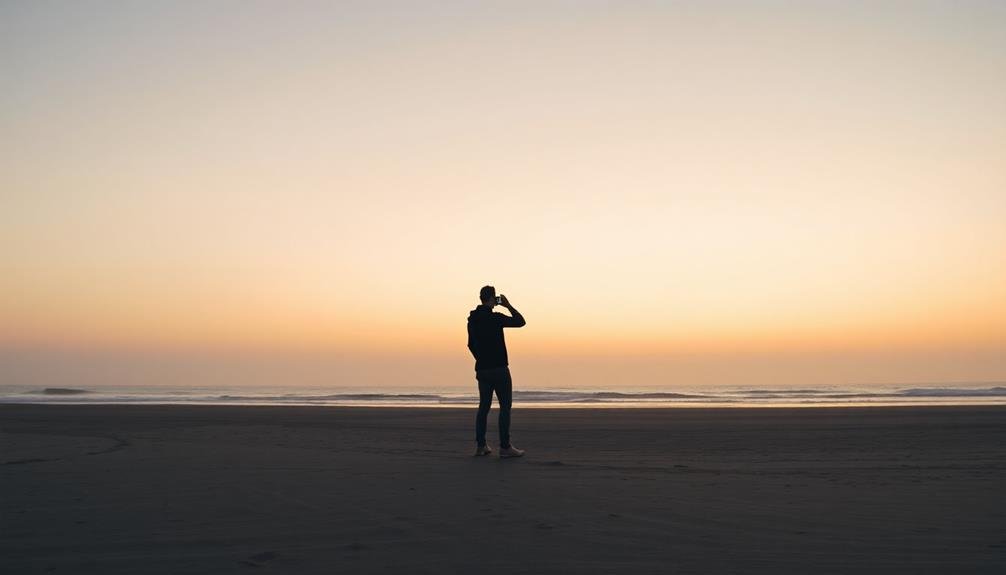
Have you ever noticed how sometimes less is more in photography? That's where negative space comes in. It's the empty area surrounding your main subject, and it can be a powerful storytelling tool in your social media posts.
Negative space creates breathing room for your viewers' eyes, allowing them to focus on what's important. It's not just about emptiness; it's about intentional composition. When you're framing your shot, look for opportunities to incorporate negative space. It can be the sky, a plain wall, or even a blurred background.
Here are three ways to effectively use negative space in your mobile photography:
- Emphasize scale: Place a small subject against a vast background to create a sense of magnitude.
- Convey emotion: Use empty space to evoke feelings of isolation, freedom, or contemplation.
- Guide attention: Direct the viewer's gaze to your focal point by surrounding it with simplicity.
Color Theory for Emotional Appeal

When creating social media stories, you'll find that color plays an essential role in evoking emotions and setting the mood.
Different hues can trigger specific feelings in your audience, such as red for excitement or blue for calm.
Hues Evoke Specific Feelings
Colors wield immense power in evoking emotions and setting the tone for your social media stories. Understanding how different hues affect your audience can help you create more impactful content.
Warm colors like red, orange, and yellow tend to evoke energy, excitement, and passion. They're great for grabbing attention and creating a sense of urgency.
Cool colors such as blue, green, and purple often elicit feelings of calm, trust, and serenity. These are ideal for conveying professionalism or promoting relaxation.
To effectively use color in your social media stories:
- Choose a dominant color that aligns with your message's emotional intent.
- Use complementary colors to create contrast and visual interest.
- Experiment with color saturation to fine-tune the intensity of emotions.
Remember that cultural context can influence color perception. What works in one region mightn't have the same impact in another.
It's essential to take into account your target audience when selecting your color palette. By thoughtfully incorporating color theory into your mobile photography, you'll create more engaging and emotionally resonant social media stories that captivate your followers and effectively convey your message.
Color Combinations Create Mood
Mastering color combinations is essential for creating the desired mood in your social media stories. By understanding how different colors interact, you'll be able to evoke specific emotions and set the tone for your content. Complementary colors, like blue and orange, create a vibrant, energetic feel, while analogous colors, such as blue and purple, offer a more harmonious and soothing atmosphere.
To effectively use color combinations, consider the following pairings and their emotional impacts:
| Color Combination | Mood/Emotion |
|---|---|
| Red + Yellow | Excitement |
| Blue + Green | Tranquility |
| Purple + Pink | Creativity |
| Black + White | Sophistication |
| Orange + Teal | Adventure |
When selecting colors for your stories, think about the message you want to convey. Warm colors like red, orange, and yellow can create a sense of urgency or passion, while cool colors like blue and green promote calmness and trust. Don't be afraid to experiment with different combinations to find what resonates best with your audience and brand. Remember, consistency in your color choices across your stories can help establish a recognizable visual identity.
Unique Angles and Perspectives

Three key techniques can transform your social media stories through unique angles and perspectives. By shifting your viewpoint, you'll capture images that stand out and engage your audience in new ways.
First, try shooting from a low angle. Crouch down or even lie on the ground to capture subjects from below. This perspective can make objects appear larger and more imposing, adding drama to your shots.
Second, experiment with bird's-eye views. Climb to a higher vantage point or use a selfie stick to shoot from above. This angle provides a unique overview and can reveal interesting patterns or compositions.
Finally, explore unconventional framing. Use natural frames like doorways or branches to add depth and context to your images.
To further enhance your unique angles:
- Use leading lines to guide the viewer's eye
- Incorporate reflections for a creative twist
- Play with symmetry and asymmetry in your compositions
Candid Moments Capture
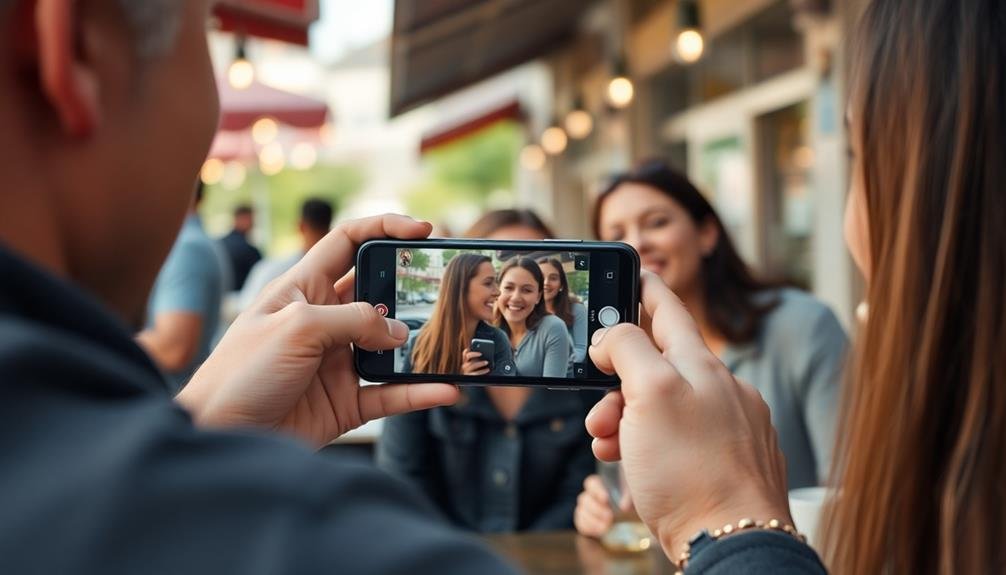
To capture authentic candid moments for your social media stories, you'll need to sharpen your observational skills and anticipate spontaneous actions.
You can master discreet shooting techniques by becoming familiar with your phone's quick-launch camera features and using silent mode.
Don't shy away from imperfect compositions; they often lend a genuine, unposed quality to your candid shots that followers find relatable and engaging.
Anticipate Spontaneous Actions
Capturing spontaneous actions requires a keen eye and quick reflexes. To anticipate these fleeting moments, you'll need to stay alert and observe your surroundings carefully. Look for subtle cues that might indicate an impending action, such as a child reaching for a toy or a dog getting ready to shake off water.
Position yourself strategically, anticipating where the action might unfold, and be prepared to quickly frame and capture the shot.
To improve your chances of catching spontaneous moments, consider these tips:
- Use burst mode or continuous shooting to capture a series of images in rapid succession.
- Pre-focus on the area where you expect the action to occur.
- Set your camera to a faster shutter speed to freeze motion.
Practice reading body language and facial expressions to predict when something interesting might happen. Don't be afraid to take multiple shots; you can always delete the ones that don't work out.
Master Discreet Shooting
Discreet shooting allows you to capture genuine, unposed moments for your social media stories. To master this technique, start by keeping your phone at the ready but not obviously visible. Hold it at waist level or against your chest, using the volume buttons to snap photos without drawing attention.
Familiarize yourself with your camera app's silent mode and turn off the shutter sound. Use a wrist strap for added security when shooting from unconventional angles. Practice framing shots without looking at your screen, relying on your instincts and knowledge of your phone's field of view.
When in public spaces, be mindful of privacy concerns. Avoid photographing people in compromising situations or private moments. If someone notices you taking their picture, be prepared to explain your intentions or delete the image if requested.
Use continuous shooting mode to capture a series of images quickly, increasing your chances of getting the perfect shot. Experiment with different lenses, like wide-angle or telephoto, to vary your perspective while maintaining distance.
Embrace Imperfect Compositions
Three key principles underpin the art of embracing imperfect compositions in candid photography.
First, accept that real life isn't perfectly framed. Instead of aiming for flawless symmetry or textbook rule-of-thirds, focus on capturing genuine moments.
Second, learn to see beauty in the chaos. Cluttered backgrounds or slightly off-center subjects can add character and authenticity to your images.
Third, prioritize emotion over technical perfection. A slightly blurry shot that conveys raw feeling is often more compelling than a razor-sharp image lacking soul.
To effectively embrace imperfect compositions, consider these techniques:
- Shoot from unconventional angles
- Incorporate intentional motion blur
- Play with negative space and cropping
Reflections and Silhouettes

Reflections and silhouettes offer powerful ways to add depth and intrigue to your social media stories. They create visual interest and encourage viewers to pause and engage with your content.
To capture stunning reflections, look for smooth surfaces like water, glass, or polished metal. Position your subject near the reflective surface and experiment with different angles to achieve the desired effect. Don't be afraid to get low or tilt your phone to find the perfect composition.
For silhouettes, place your subject between your camera and a strong light source, such as the setting sun or a bright window. Adjust your phone's exposure by tapping on the brightest part of the screen, which will darken the foreground and create a striking silhouette. Play with various poses and shapes to make your silhouettes more dynamic and recognizable.
Both techniques work well for storytelling on platforms like Instagram Stories or TikTok. Use reflections to show multiple perspectives or create symmetry, and employ silhouettes to build mystery or emphasize emotions through body language.
Remember to keep your compositions simple and focused to maximize impact in the limited attention span of social media viewers.
Texture and Pattern Focus
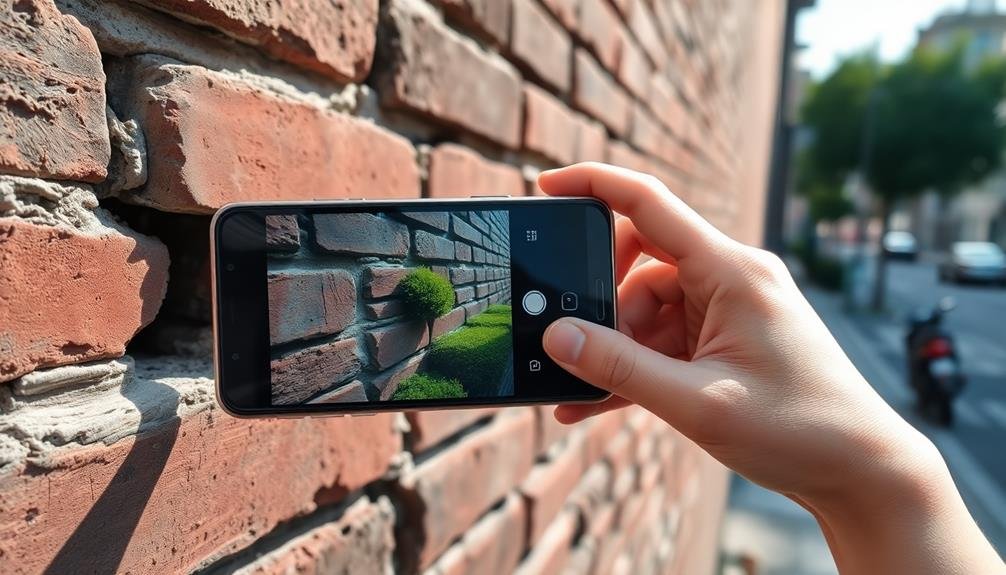
Texture and pattern photography can transform ordinary scenes into enchanting visual stories for your social media posts. By focusing on these elements, you'll create visually striking images that captivate your audience. Look for interesting textures in everyday objects, from rough tree bark to smooth pebbles on a beach. Patterns can be found in both natural and man-made environments, such as repeating architectural features or the symmetry of flower petals.
To capture compelling texture and pattern photos:
- Use natural light to enhance shadows and depth
- Experiment with different angles to emphasize the subject's unique qualities
- Try macro photography to reveal intricate details
When composing your shot, consider filling the entire frame with the texture or pattern for maximum impact. This technique works particularly well for abstract images that leave viewers intrigued.
Don't be afraid to play with contrast and color to further accentuate the visual elements. Remember, successful texture and pattern photography often relies on simplicity, so avoid cluttering your image with unnecessary elements.
Depth of Field Manipulation

Mastering depth of field manipulation is a game-changer for your mobile photography. It allows you to control which parts of your image are in focus, creating a sense of depth and guiding the viewer's eye to your subject.
Most smartphones now offer portrait mode, which simulates a shallow depth of field by blurring the background. To use this effectively, get close to your subject and verify there's distance between them and the background. Experiment with different angles to maximize the blur effect.
For a deeper depth of field, where more of the image is in focus, switch to your phone's standard photo mode and tap to focus on the middle ground.
Don't forget about manual focus options in third-party camera apps. These give you more control over your focus point and depth of field. Try focusing on foreground elements to create interesting frames, or use the rule of thirds to place your subject off-center for a more dynamic composition.
Frequently Asked Questions
How Can I Stabilize My Phone for Clearer Shots in Low Light?
You can stabilize your phone for clearer low-light shots by using a tripod or leaning it against a stable surface. Try using your phone's timer or voice commands to avoid shake when pressing the shutter button.
What Apps Are Best for Advanced Mobile Photo Editing?
You'll find Snapseed, VSCO, and Lightroom Mobile are exceptional for advanced mobile editing. They offer pro-level tools like selective adjustments, curves, and RAW processing. Adobe's Photoshop Express is also great for quick, powerful edits.
How Do I Protect Image Quality When Sharing Across Different Platforms?
To protect image quality across platforms, you'll want to save in high resolution, use lossless formats like PNG, avoid over-compression, and consider each platform's specific requirements. Don't forget to resize appropriately for different social media sites.
What Are the Ideal File Formats for Mobile Photography?
For mobile photography, you'll want to use JPEG or HEIC formats for most purposes. They offer good quality with smaller file sizes. If you're editing, RAW files provide more flexibility but take up more space.
How Can I Create Consistent Visual Branding Across My Social Media Posts?
To create consistent visual branding, you'll want to stick to a specific color palette, use similar filters, maintain a cohesive theme, and employ consistent fonts. Don't forget to include your logo or watermark across all posts.
In Summary
You've now got a toolkit of mobile photography techniques to elevate your social media stories. Remember, it's not just about capturing images; it's about telling compelling visual narratives. Don't be afraid to experiment with these methods, mixing and matching them to create your unique style. As you practice, you'll develop an eye for spotting photo opportunities everywhere. Keep shooting, keep sharing, and watch your storytelling skills soar. Your followers will thank you.



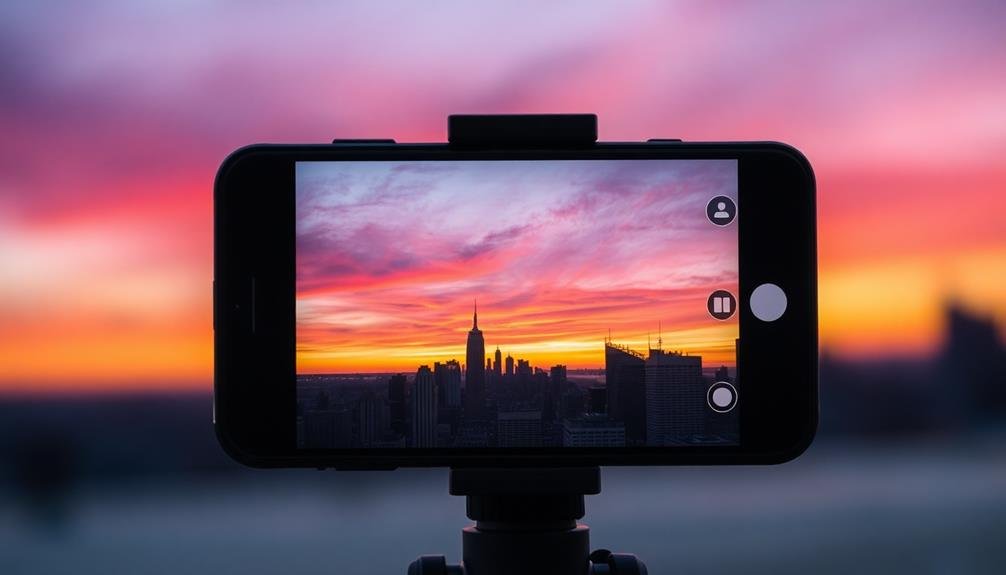

Leave a Reply